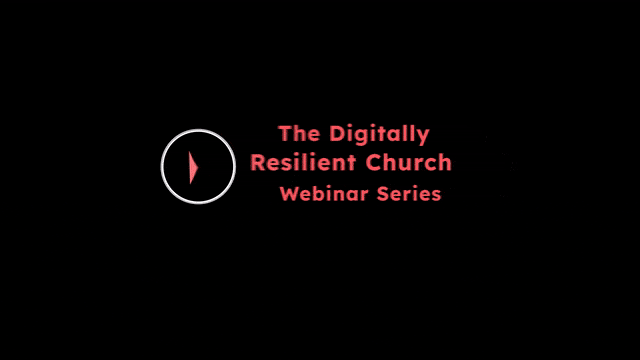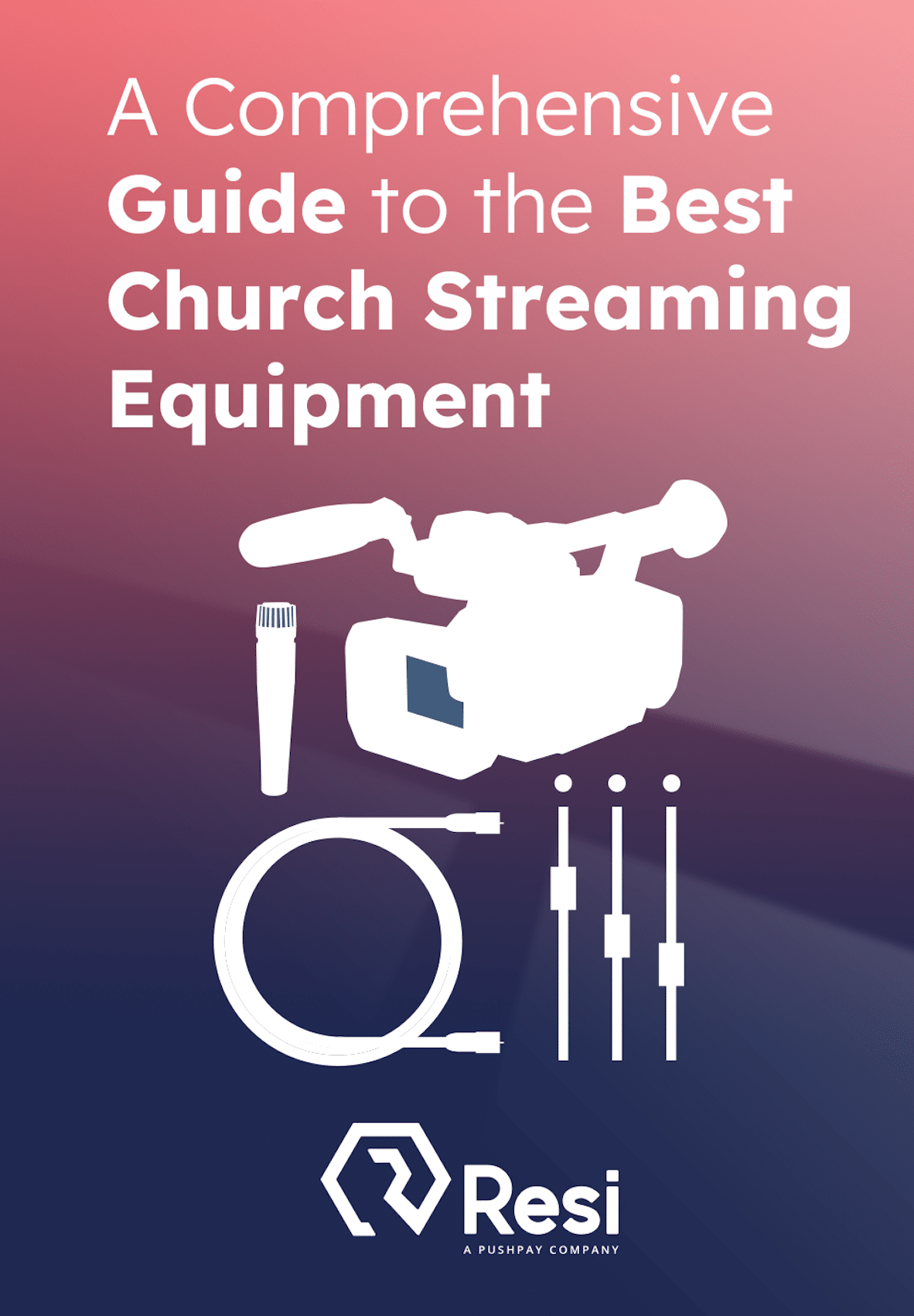
In a recent non-scientific poll held by Resi during Part 3 of their Digitally Resilient Church Online Event, a surprising 55% of church respondents said they don’t follow up with their new online viewers from their livestreamed church services.
That percentage seemed surprisingly high to me. After all, potential guests to your physical buildings will often attend online services up to six times before they come to your building. So with potential visitors engaging through livestream church services before they come to the building, why wouldn’t you engage with people before they come to your building?
Why should you follow up with livestream church service visitors?
The Parable of the Talents (Matthew 25) is very telling in this scenario. The master gives five talents to the servant, who multiplies the talents to ten. The servant who receives two talents doubles it to four. Another servant receives one talent and does nothing with it. I would challenge that churches livestreaming services and not following up or engaging with viewers digitally are comparable to the servant with one talent.
We’re effectively burying potential relationships in the sand, waiting for them to mature to the level they will bring themselves into the building. True, a (small) percentage will probably make it to the building. But that’s a minuscule percentage compared to what could be if churches engage digitally. I believe this makes for an unhappy master!
Beyond livestreaming church services: Battling the “church online autopilot”
I recently had a conversation with a volunteer over at Life.Church – David Dibert is one of the lead tech support volunteers for Church Online Platform (ChOP), as run by Life.Church. If ChOP, for some reason, isn’t working, chances are you’ll be talking to Dave via email at some point.
Best Livestreaming Equipment
Discover what top-rated equipment we recommend adding to your church streaming toolkit.
Download for free!
In my conversation with Dave, he summarized the problem many churches are experiencing in this new post-Covid world: Churches are looking at their online streams and figuring out how to put them on “autopilot.” When I say autopilot, I’m not speaking of the technical aspects. Resi’s best-in-class “set-it-and-forget-it” livestreaming solutions are designed to remove technical complexities from the user experience. We want this. “Church Online Autopilot” speaks more to the challenge of digital ministry being hands-off or uninvolved instead of being involved and active digitally.
While livestreaming technology can massively scale, the same technology can also be highly relational — allowing you to build a relationship with someone across the street or worldwide. Resi’s technology does an incredible job of getting your church services online in a stable fashion, but we need to recognize that opportunities lie beyond the stream. What are we doing with the resources given?
We previously discussed the six things potential visitors want before entering your building. Some of them (worship, preaching, livestream quality) are passive. The online viewer wouldn’t benefit from outside help to learn about your church’s worship culture or preaching style. They’ll see that in the stream. That being said, the others (representation, authenticity, relevance) can and should be complemented with outside help via follow-up from pastors, staff, or qualified volunteers.
In many ways, the stream serves as the front door to connecting with people digitally. Through digital connections, we build relationships that ultimately lead to building trust, which will attract people to our building. Building trust cannot be done passively. We must actively engage digitally.
How should your church follow up with potential visitors from your livestream church services?
Typically, churches are recommended to use whatever platform the visitor uses with the church. For example, if the visitor attended the livestream church service on Facebook, the church should use Facebook Messenger to direct message/communicate with the individual. If they engaged on YouTube, then comment back and at least start the conversation on YouTube.
Visitors typically do not want to digitally give you their email address or phone number. However, analytics show they’ll reply to Facebook Messenger or other social media DMs. An interesting tip: Even outside of your livestream church services, consider direct messaging anyone who likes or comments on your Facebook or Instagram post, story, or reel. Reels and shorts are getting massive exposure to new people, creating new engagement opportunities. What if your church connected with these people via social media — engaging and dialoguing with new people?
Speaking of opportunities outside the online church service broadcasts, sermons on-demand are also a vast, untapped resource! Sermon archives provide an accessible, simple, shareable resource that your physical church attendees can easily share with their friends. Resi provides an incredible feature set to maximize engagement for shareable resources like sermon archives. Resi’s On Demand feature set gives access to a pre-roll/post-roll feature. Essentially, Resi will automatically put bumpers in front of every sermon…. This incredible opportunity to lead viewers to a connection form, a digital community, or interact in real-time with your staff and volunteers via software like Intercomm.io.
As you can see, many opportunities exist to follow up and engage with potential visitors. So, turn off the “autopilot” mindset and develop an official follow-up process. Most church management systems can offer solutions to this. Craft a follow-up process incorporating emails and to-do assignments to remind the church to engage via social media DM (or whatever platform is necessary). Understand that you should “automate the process” (coding repeatable action steps and to-dos into a system) that will allow personal interactions to scale digitally. You do not want to “automate the connections” to the extent that the potential visitors interact exclusively with chatbots and scripted material. Show visitors your church’s authenticity!
As helpful as it is for pastors to converse with potential visitors online, it’s equally valuable for volunteers — i.e., “normal people” — to engage online. Moving beyond pastoral staff and empowering volunteers to represent the church digitally is necessary in most churches. To be honest, most pastors struggle with simple digital engagement processes. It’s just not how they’re wired! However, building a follow-up team will go a long way in establishing a digitally relatable culture for your church.
Best Livestreaming Equipment
Discover what top-rated equipment we recommend adding to your church streaming toolkit.
Download for free!
Speaking of relatable, I know of a church with a webpage where visitors can “book a coffee meeting with the lead pastor.” Tons of people visit the page, and the church has received feedback about how cool the lead pastor is that he’d be willing to have a coffee meeting with any visitor who can sit down and talk with him. The lead pastor only got booked once or twice a quarter, which is not a lot of time, but the fact that he’s willing to meet with people speaks volumes about the authenticity of the church’s culture.
8 best practices for following up after livestream church services
- It’s better to ask questions than make statements. Take the time to get to know the visitors. Ask lots of questions, giving the new person the opportunity to speak. The more you get them to talk, the more trust you build with the individual. The more you listen to them, the more they will listen to you. Make sure follow-up is a two-way conversation, not a monologue.
- Follow up, quickly. A good rule of thumb is 24 hours. Sounds crazy, but digitally expectations move quickly. If you are not engaging with someone within 24 hours, the chance of you getting any engagement from the visitor drops significantly. Teach this urgency to your staff and volunteer teams. Build a process that can respond and connect quickly.
- Care about people, not about your Sunday building headcount. Is your goal in the conversation to get to know the person relationally or to invite them to a church building? Your motives may be pure in inviting them to the church building, but it can be perceived as impersonal if you’re pushing an agenda before you connect relationally.
- Don’t ask for personal information until necessary. People have far more trust in physical space than digitally. Asking for a phone number or email address can kill a conversation or prevent people from completing an online connection form. Always ask for as little information as needed, and lean on social media profiles as much as possible. People are more willing to share their social media information than their email or phone number. There is a point where you earn the trust to ask for people’s contact info… and it’s not right away.
- Have a plan for suicidal or mentally ill scenarios. If you are actively following up with people from livestream church services, you will eventually run into someone who is thinking of harming themselves. As a church, establish a process for how your staff or volunteers will handle these situations. Don’t be afraid to partner with other organizations and hand off as smoothly as possible. Involve authorities as well. We want what’s best for the individual, and sometimes, admitting we’re not what’s best can make a big difference.
- Simplify CTAs (Call-To-Actions) in livestream church services. This is probably good advice for physical church services as well. Often, church ministries feel pressured to get their particular event or ministry announced in the church service. This can be confusing to visitors. Simplifying your call to action will allow for better engagement from potential visitors. Don’t be afraid to integrate Resi’s QR Click into the process! Put the QR code often on the screen (as a lower third) and invite people to connect with you during musical worship or the message.
- Experiment with digital community. This isn’t a proven best practice, but we are seeing success with churches experimenting with funneling visitors from livestream church services into a digital community like a Facebook Group or a WhatsApp channel and then using the digital community to build relationships with people. Globally, building relationships via digital communities is a proven process and is now beginning to gain some exposure with American churches. If I could get a visitor to do one thing, I would prefer them to join a digital community, even over giving me personal information like a phone number or email address.
- Don’t automate people out of the process. We’ve discussed this many times already, but it’s important enough to highlight again. Remember, potential visitors seek authenticity, and trust is built slowly via digital methods. Lean into the relational power of engaging people digitally and develop a follow-up process for your church that allows for automation and personal interactions from Pastors, staff, and even volunteers that allow potential visitors to build trust with your church.
Maximize the potential of your livestream church service to reach potential visitors. Using Resi’s technology to connect with new people is the beginning of the process. Don’t autopilot everything afterward. Create an effective follow-up process that will allow you to engage and build relationships with your livestream visitors!







